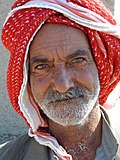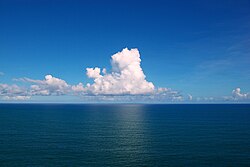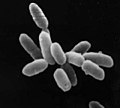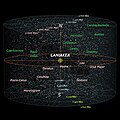Earth
third planet from the Sun in the Solar System From Wikipedia, the free encyclopedia
Remove ads
Earth is the third planet from the Sun and the only place we know of where life exists. One big reason life can exist here is that Earth is an “ocean world.” This means it has a lot of water on its surface, and it is the only planet in our Solar System with liquid water that life can use. Most of Earth’s water is in the oceans, which cover about 71% of the planet’s surface. The rest, about 29%, is land. Most of this land is grouped into large continents, like North America, Africa, and Asia, which are mostly humid and covered with plants. Even the icy parts at the North and South Poles hold more water in their ice sheets than all of the lakes, rivers, and underground water combined.[22]
Earth’s outer layer, called the crust, is made of big pieces called tectonic plates that slowly move around. When these plates push against each other, they can create mountains, volcanoes, and earthquakes. You can think of it like giant puzzle pieces slowly sliding and bumping into each other. Deep inside Earth, there is a liquid outer core. This spinning liquid creates a magnetic field around the planet, called a magnetosphere. The magnetosphere works like a protective shield, keeping most of the dangerous solar winds and cosmic radiation from reaching the surface, which helps life survive.[22]
Earth has an atmosphere, which is a layer of gases that surrounds the planet. This atmosphere is very important because it keeps Earth’s surface conditions just right for life. It also protects us from most meteoroids that hit Earth and from harmful ultraviolet (UV) light from the Sun. Most of the atmosphere is made of nitrogen and oxygen, the gases we breathe. There is also water vapor in the air, which forms clouds that cover much of the planet. The water vapor and other gases, like carbon dioxide (CO2), help trap energy from the Sun. This is called the greenhouse effect. You can think of it like a blanket around Earth: it keeps the planet warm enough for liquid water to exist on the surface. Because of this, the average temperature on Earth is about 15 °C (59 °F), which is perfect for water to stay liquid instead of freezing or evaporating too quickly. Different parts of Earth get different amounts of sunlight. For example, the equator gets more sunlight than the poles. This difference causes winds in the atmosphere and currents in the oceans, moving heat and water around the planet. These movements create the global climate system, which includes different climate zones, like deserts, rainforests, and polar regions. They also cause weather events like rain and snow, and help important elements like carbon and nitrogen move through the environment, which is essential for life.[22]
Earth is shaped like a slightly squashed ball, called an ellipsoid. If you could travel all the way around it at the equator, you would cover about 40,000 kilometers (about 25,000 miles). Earth is the densest planet in our Solar System, which means it has more mass packed into its size than any other planet. Among the four rocky planets, Mercury, Venus, Earth, and Mars, Earth is the largest and heaviest. Earth is about 150 million kilometers (93 million miles) from the Sun, which is also called 1 astronomical unit, or 1 AU. Light from the Sun takes about eight minutes to reach us. Earth travels around the Sun in an orbit, taking one year, about 365.25 days, to complete a full circle. At the same time, Earth spins around its own axis once every day, which actually takes about 23 hours and 56 minutes. The axis is tilted, which is why we have seasons: when one side leans toward the Sun, it is summer there, and when it leans away, it is winter. Earth has one natural satellite, the Moon. The Moon orbits Earth at about 384,400 kilometers (238,855 miles), which is 1.28 light seconds away. The Moon is about one-quarter the size of Earth. Its gravity affects Earth in important ways. It helps keep Earth’s tilt stable, creates tides in the oceans, and slowly makes Earth spin a little slower over time. At the same time, Earth’s gravity has locked the Moon so that the same side always faces us.[22]
Earth formed about 4.5 billion years ago from clouds of gas and dust in the early Solar System. You can imagine it like tiny pieces of dust sticking together to slowly build a planet. During the first billion years, oceans formed on Earth, and soon after, life began in these waters. Over time, life spread all over the planet and started changing the air and the surface of Earth. About two billion years ago, this led to the Great Oxidation Event, when oxygen became common in the atmosphere for the first time. Humans appeared much later, around 300,000 years ago, starting in Africa. Since then, humans have spread to every continent. People rely on Earth’s plants, animals, water, and other natural resources to survive. But as human populations have grown and technology has advanced, we have started to change the environment in big ways. Today, human activities are affecting Earth’s climate and ecosystems in ways that are not sustainable. This means that if things continue as they are, it could make it harder for humans and many other living things to survive. Our impact is causing problems like climate change, loss of habitats, and extinction of species, which shows how important it is to take care of the planet.[22]
Remove ads
Etymology
The English word Earth comes from the Old English word eorðe, which was used hundreds of years ago.[23] Similar words exist in many Germanic languages, and scientists think they all come from an even older word called Proto-Germanic erþō. In the past, the word eorðe was used to mean many things, just like the Latin word terra or the Greek word gē. It could mean the ground, the soil, dry land, the human world, the surface of the planet (including the seas), or even the planet as a whole. Basically, it was a word for almost anything we associate with the world we live on. Long ago, like in Roman and Greek stories, people sometimes imagined Earth as a goddess. In Norse mythology, for example, there was Jörð, a giantess who represented the Earth and was said to be the mother of Thor, the god of thunder.[24]
In the past, the word “earth” was usually written with a lowercase “e.” During the Early Middle English period, people started using the phrase “the earth” to mean the whole planet, or the globe. Later, in the Early Modern English period, people began capitalizing nouns more often, so you also started seeing “the Earth”, especially when talking about it along with the Sun, Moon, or other planets. Today, people sometimes just write “Earth” with a capital letter, like the names of other planets, but the lowercase form “earth” is still very common.[23] Different books and style guides have different rules. For example, the Oxford style says lowercase is more common, but capitalized “Earth” is also okay. A common rule is to use a capital “E” when Earth is a proper name, like in “Earth’s atmosphere”, but use lowercase when it is part of a description, like “the atmosphere of the earth.” In everyday expressions, we almost always use lowercase, like in the saying “What on earth are you doing?”[25]
The planet Earth has had many names throughout history. Terra is one of these names. Scientists sometimes use it in writing, and science fiction writers use it to make it clear they are talking about our planet and not another one.[26] In poetry, the name Tellus has been used to imagine Earth as a person, like giving the planet human qualities. Some languages, called Romance languages because they come from Latin, use Terra or similar words as the name for Earth. For example, Italian and Portuguese still call it Terra. In Spanish, it became Tierra, and in French, it became Terre. You can think of it like how a single family recipe can change a little in different countries. The Greek name for Earth was Gaia, or sometimes spelled Gaea in English. This name is used less often, but it became more popular with the Gaia hypothesis, which is a scientific idea that Earth works like a living system. With this, people usually say it as GYE-uh instead of the older English pronunciation GAY-uh.[27]
There are many words that come from the names of the planet Earth. For example, the word earthly comes directly from the word Earth. People use it to describe things that belong to or come from our planet. Other words come from the Latin name Terra. From this, we get terran,[28] terrestrial,[29] and terrene.[30] These words all mean “related to Earth” or “living on Earth.” For example, scientists might call animals that live on land “terrestrial animals,” like lions, elephants, and humans. Some words come from the Latin name Tellus, like tellurian and telluric. These words also mean “related to Earth.”[31][32]
Remove ads
Natural history
Formation

The oldest solid stuff in the Solar System is made of tiny pieces called CAIs, which stands for calcium–aluminium-rich inclusions. These pieces are found in some very old meteorites. Scientists have measured them and found that they are about 4.568 billion years old. These were the very first solid materials that formed from a big cloud of gas and dust in space, called the solar nebula, which later made the Sun and planets. Earth formed a little later, around 4.54 billion years ago.[33][34]
A long time ago, there was a huge cloud of gas and dust in space called a molecular cloud. Gravity pulled part of this cloud together, which made it shrink, spin, and flatten into a disk around the forming Sun. This disk is called the solar nebula. It had gas, ice, dust, and even radioactive materials like uranium and thorium, which gave off heat as they broke down. Tiny dust particles in the disk bumped into each other and stuck together. Over time, these clumps grew into larger rocks called planetesimals, which were the building blocks of planets. Earth grew by slowly collecting these pieces, a process called accretion, which took about 70 to 100 million years. As smaller bodies crashed into the growing Earth, they created a lot of heat, melting parts of the planet. When Earth first formed, it was very hot and mostly molten, like a giant ball of lava. Over time, it cooled and separated into layers. The heaviest metals sank to make the core, lighter rocks formed the mantle, and the outer layer became a basic crust.[35]
Scientists are still studying how the Moon formed. They think it is about 4.5 billion years old, but it might be a little younger depending on how it is measured.[36] The most accepted idea is called the Giant Impact Hypothesis. According to this idea, a planet-sized object called Theia, about one-tenth the size of Earth, collided with early Earth.[37] The collision was not straight-on but more like a glancing blow. Pieces of Theia and Earth’s outer layer broke off, forming a ring of debris around Earth. This debris later came together to make the Moon. The collision also changed Earth’s spin and tilted its axis.[38][39]
After the Moon formed, the inner Solar System went through a time called the Late Heavy Bombardment, about 4.0 to 3.8 billion years ago. During this time, many asteroids and comets crashed into the Moon and Earth, making large craters on the Moon, like Imbrium, Serenitatis, and Crisium. Some impacts may have melted parts of the Moon’s crust and caused volcanic activity. On Earth, these impacts affected the surface and atmosphere and might have helped life start by bringing water and organic molecules, or by creating hot underwater areas called hydrothermal vents, which can support life. Scientists think the movements of giant planets, like Jupiter and Saturn, may have disturbed the orbits of asteroids and comets, sending them toward the inner planets and causing this heavy bombardment.[40]
After formation

Most of Earth’s air and water came from volcanoes. When volcanoes erupted, they released gases trapped inside the planet. This process is called outgassing. These gases included water vapor, carbon dioxide, nitrogen, and small amounts of other gases.[42] The water vapor cooled down and formed the first oceans. Some water also came from space, brought by asteroids, icy protoplanets, and comets.[43] These space objects added more water from different parts of the Solar System. Scientists think there might have been enough water to fill today’s oceans very soon after Earth formed, so our planet was basically “wet” from the start.[44]
Back then, the young Sun was only about 70% as bright as it is now. Normally, this would have made Earth very cold. But greenhouse gases like carbon dioxide and methane trapped heat, keeping the oceans from freezing. This made Earth warm enough for liquid water, which is important for life.[45] Around 3.5 billion years ago, Earth also developed a magnetic field, created by the movement of molten iron in the core. This magnetic field acted like a shield, protecting the atmosphere from being blown away by the solar wind, which helped Earth keep its water and stay stable for life.[46]
As Earth cooled, the molten outer layer hardened to form the first crust, mostly made of mafic rocks that are rich in iron and magnesium but low in silica. Later, the first pieces of continental crust appeared. These rocks were more felsic, meaning they had more silica, aluminum, potassium, and sodium. Scientists think these formed when parts of the mafic crust melted at very high temperatures, helped by early tectonic activity or mantle plumes.[47]
The oldest continental crust is known from tiny minerals called zircons, some of which date back to 4.4 billion years ago, only about 140 million years after Earth formed.[48] Scientists are still figuring out how these small pieces of crust grew into the large continents we have today.[49] Some think growth was slow and steady over billions of years.[50][51] Others think most continents formed quickly during the Archean eon. Both ideas could be true because the crust was constantly recycled, subducted, eroded, and melted, changing early continents over time.[52]
New continental crust still forms today thanks to plate tectonics, which is the movement of large pieces of Earth’s crust. Heat from inside Earth causes mantle convection, where hot rock slowly rises and sinks. This drives processes like subduction (one plate sliding under another) and volcanoes. Over millions of years, these movements cause continents to come together into supercontinents and then break apart. For example:
- Rodinia started breaking apart ~750 million years ago
- Pannotia formed ~600–540 million years ago
- Pangaea began breaking ~180 million years ago
The movement and collision of continents affect Earth’s surface, climate, oceans, and life. When continents collide, they form mountains. When they pull apart, they create valleys and basins where sediments collect. These changes have influenced the evolution of plants, animals, and humans over millions of years.[53]
Earth’s climate has gone through many ice ages, when large parts of the planet were covered in ice. These started around 40 million years ago and became very strong during the Pleistocene epoch (~3 million years ago).[54] Areas far from the equator went through repeated cycles of glaciation (ice sheets growing) and thawing (ice melting). These cycles happen because of small changes in Earth’s orbit and tilt, called Milankovitch cycles, which change how sunlight hits Earth roughly every 21,000, 41,000, and 100,000 years.[55] The most recent ice age, called the Last Glacial Period, covered large parts of continents with thick ice sheets. It ended about 11,700 years ago, marking the start of the Holocene epoch. Since then, Earth’s climate has been relatively stable, which allowed humans to build civilizations and thrive.[56]
Origin of life and evolution
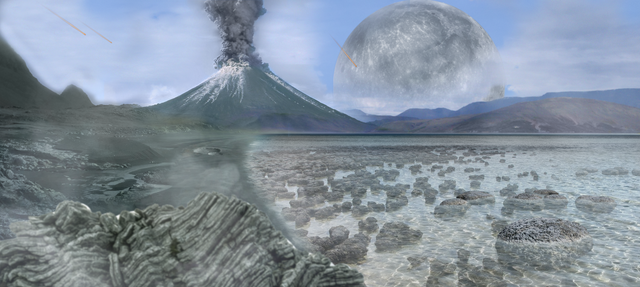
Scientists think life on Earth began about 4 billion years ago. It likely started with simple chemical reactions that made the first molecules able to copy themselves. These molecules were probably short pieces of RNA, which is similar to DNA. RNA is important because it can both store instructions (like a recipe book) and speed up chemical reactions. The fact that these molecules could copy and change over time was the very beginning of evolution. Around 3.5 billion years ago, something very important appeared: the Last Universal Common Ancestor (LUCA). LUCA was not the very first life, but it was the ancestor of all living things we know today, from bacteria and archaea to plants and animals. LUCA already had the basic tools of life that every organism still uses. It could copy DNA, read it into RNA, and build proteins from those instructions. It also had ways to get energy, either from chemical reactions or from sunlight. In other words, LUCA was like the great-grandparent of all life on Earth, passing down the same core tools that living things still use billions of years later.[58]
A huge change in Earth’s history happened when some bacteria learned how to do photosynthesis, the process of using sunlight to make energy. Plants do this today, but the first organisms to do it were tiny bacteria called cyanobacteria. When they made energy from sunlight, they released oxygen as waste. At first, Earth’s air had almost no oxygen. But over hundreds of millions of years, oxygen built up in the atmosphere. About 2.4 billion years ago, during the Great Oxidation Event, oxygen became much more common. Some of this oxygen turned into the ozone layer, a shield high above Earth that blocks dangerous UV rays from the Sun. Thanks to this protection, life could eventually move from the oceans onto land. Oxygen also changed the way life got energy. Before oxygen, organisms used less efficient methods that did not give them much power. But with oxygen, they could do aerobic respiration, which makes much more energy from food like glucose. This extra energy allowed larger and more complex life to evolve.[59]
Another big step was when life went from simple cells to complex cells. This happened through a process called endosymbiosis, which means “living together inside.” Long ago, some small cells started living inside bigger ones. Instead of being eaten, the smaller cells became permanent helpers. Over time, they turned into organelles, special parts of complex cells. For example, mitochondria make energy, and chloroplasts (in plants) do photosynthesis. These new complex cells are called eukaryotic cells, and they have a nucleus (a control center).[60] Eventually, they started living in groups. At first, they formed loose colonies, but later they became multicellular organisms, where cells had different jobs, like protecting, gathering food, or reproducing. This teamwork made life much more advanced. Meanwhile, the ozone layer kept protecting Earth, allowing living things to slowly spread from oceans to land.[61]
Scientists have found fossils that prove life is very old. For example, tiny structures made by microorganisms have been found in rocks 3.45–3.7 billion years old. Even some rocks from 4.1 billion years ago show signs of life. These fossils include microbial mats (thin layers of bacteria), tiny cell-like shapes, and special carbon (graphite) that likely came from living things.[62][63][64] Much later, between 1,000 and 539 million years ago, Earth may have gone through a frozen period called Snowball Earth, when ice covered nearly the whole planet, even near the equator. After this icy time came the Cambrian explosion about 535 million years ago. Life suddenly became much more diverse. Many major groups of animals we know today first appeared then, including animals with shells, backbones, and specialized body parts.[65][66]
Over Earth’s history, there have been at least five major mass extinctions. A mass extinction is when a huge number of species die in a short time. Each one reshaped ecosystems and forced life to evolve in new ways.[67] The most famous mass extinction happened about 66 million years ago when a giant asteroid hit near today’s Yucatán Peninsula in Mexico. This caused massive climate changes and wiped out the dinosaurs that could not fly (non-avian dinosaurs) along with many other reptiles. But smaller animals, like mammals, birds, lizards, and insects, survived. Because of this, mammals had the chance to grow and spread, eventually becoming the dominant animals on Earth.[68]
After the dinosaurs died out, mammals quickly evolved to fill many different roles. Some stayed small and fast, while others grew large. A few million years ago, one type of ape in Africa changed in an important way. It started walking on two legs.[69] This freed up its hands to carry things and make tools. Tool use encouraged more complex communication and the growth of larger brains. This path eventually led to the first humans. Humans changed the world in powerful ways. They learned farming, tamed animals like dogs and cows, and built civilizations. These advances let humans shape the land, grow in numbers, and change entire ecosystems. Today, human activity is causing many plants and animals to go extinct much faster than normal. Cutting down forests, polluting air and water, hunting too much, and causing climate change are all big factors. Many scientists believe we may now be living through a new mass extinction, called the Holocene extinction, caused mostly by humans.[70]
Future
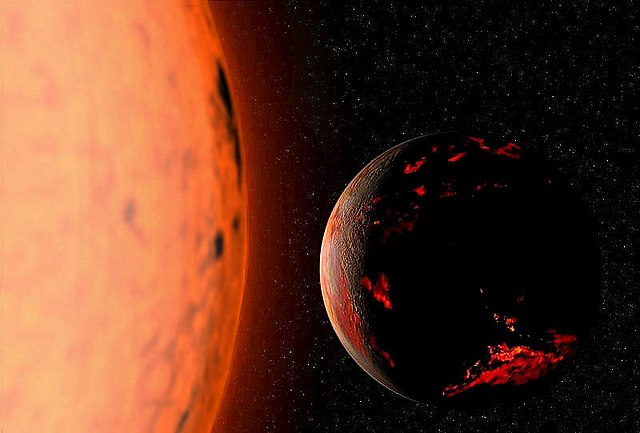
Earth’s future is closely tied to the Sun, because the Sun’s energy controls our climate, atmosphere, and even our orbit. As the Sun changes over time, Earth will change too. In the next 1.1 billion years, the Sun will shine about 10% brighter than today. That might not sound like much, but it will make Earth much hotter. In about 3.5 billion years, the Sun could be 40% brighter, making Earth almost impossible for life to survive. This happens because inside the Sun, hydrogen is fused into helium. As the core changes, the Sun slowly shines more strongly. Even small changes in sunlight can upset Earth’s climate system and make the planet hotter.[71]
One of the first big problems will be the loss of carbon dioxide from the air. Plants need CO₂ for photosynthesis, which makes food and releases oxygen. But as Earth gets hotter, rock weathering (rain and heat breaking down rocks) will speed up. This process traps carbon in rocks instead of leaving it in the air. Today, CO₂ levels are over 400 ppm. In 100 to 900 million years, CO₂ levels may drop so low, below 10 parts per million (ppm), that even the toughest plants would not survive.[72][73] Without plants, there will be no photosynthesis, so oxygen will slowly disappear. Without oxygen, animals, including humans cannot survive. This means Earth will eventually become uninhabitable for all oxygen-breathing life.[74]
As the Sun keeps brightening, Earth will get even hotter. In about 1.5 billion years, the average temperature could reach 100 °C (212 °F), the boiling point of water. The oceans would start to boil away. As water evaporates, huge amounts of water vapor (a strong greenhouse gas) would fill the air. This would trigger a runaway greenhouse effect, where Earth heats up uncontrollably, just like Venus, which is now over 460 °C (860 °F). Scientists think this would happen in about 1.6 to 3 billion years. By then, all oceans would be gone, and Earth’s water would escape into space.[75] Even if the Sun stayed stable, Earth would still slowly lose water. Some ocean water sinks into the mantle at tectonic plate edges. Normally, volcanoes return some water, but as Earth’s interior cools and volcanic activity slows, less water comes back. Over billions of years, Earth would still dry out.[75][76]
In about 5 billion years, the Sun will run out of hydrogen in its core. Fusion will shift to outer layers, and the Sun will swell into a red giant, about 250 times wider than today. Its size could reach 1 astronomical unit (AU), which is Earth’s current distance from the Sun. Mercury and Venus will be swallowed.[71][77] Earth’s fate is uncertain. The Sun will lose about 30% of its mass as strong stellar winds blow gas into space. With less mass, the Sun’s gravity will weaken, and Earth could drift outward to about 1.7 AU, possibly safe. But other forces, like tidal pulls and drag from the Sun’s outer gases, might slow Earth down. If that happens, Earth could spiral inward and be swallowed, burning up inside the Sun. After its red giant phase, the Sun will shed its outer layers, creating a glowing planetary nebula. Its core will shrink into a white dwarf, a small, dense star made mostly of carbon and oxygen. Whether Earth survives in a distant orbit or is destroyed inside the Sun is still a mystery.[71]
Remove ads
Physical characteristics
Size and shape

Earth is shaped like a round ball, but it is not a perfect sphere. Its shape is kept by a balance between two main forces. Gravity pulls everything toward Earth’s center, while pressure inside the planet and Earth’s spinning motion push outward. Together, these forces make Earth mostly round.[78] Earth’s average diameter is about 12,742 kilometers (7,918 miles), making it the fifth largest planet in the Solar System. Only the giant planets, Jupiter, Saturn, Uranus, and Neptune, are bigger. Earth is the largest rocky planet, bigger than Mercury, Venus, and Mars. Being this big gives Earth enough gravity to hold onto a thick atmosphere, which helps life survive. Smaller planets, like Mars, lost much of their air over time because they don’t have enough gravity to keep it.[79]
Because Earth spins once every 24 hours, it is not perfectly round. It bulges slightly at the equator and is a bit flattened at the poles. Scientists call this shape an oblate spheroid. The equator is about 43 kilometers (27 miles) wider than the distance from pole to pole. This happens because of centrifugal force, a pushing-out effect caused by spinning. Earth spins fastest at the equator, about 1,670 km/h (1,040 mph), while the poles do not spin at all. The equatorial radius (distance from the center to the equator) is about 6,378 km (3,963 miles). The polar radius is slightly smaller at 6,357 km (3,950 miles).[80][81]
Earth’s surface is not smooth. Tectonic activity, erosion, volcanoes, and the movement of rocks create mountains, valleys, and trenches. The deepest place is the Mariana Trench in the Pacific Ocean, about 10,925 meters (35,843 feet) below sea level.[82] The tallest mountain on land is Mount Everest, rising 8,848 meters (29,029 feet) above sea level.[83] But the place farthest from Earth’s center is not Everest, it is Chimborazo, a volcano in Ecuador. It is only 6,263 meters (20,548 feet) tall, but because it sits near the equator, where Earth bulges, its peak is 2 kilometers farther from the center than Everest.[84][85]
Just like land has mountains and valleys, the oceans have their own shapes, but they are not solid. Ocean surfaces are always moving because of winds, tides, currents, gravity, and Earth’s spin. Some parts of the ocean are slightly higher because strong gravity pulls water toward denser rocks under the seafloor. Ocean currents are affected by the Coriolis effect, caused by Earth’s spin, creating big circular patterns called gyres. For example, in the Pacific Ocean, the surface in the western Pacific is about 60 centimeters (2 feet) higher than in the eastern Pacific because of trade winds and ocean circulation.[86]
Scientists study Earth’s real shape in a field called geodesy. Instead of looking at uneven land and moving oceans, they use a model called the geoid. The geoid shows what Earth would look like if it were covered with perfectly still water, no waves, tides, or winds. The geoid is not a perfect sphere or simple oval. It is slightly bumpy, because some parts of Earth’s crust and mantle are denser, creating stronger gravity in those spots. The geoid is very useful because it acts as a baseline for measuring heights and depths, like how tall mountains are or how deep the oceans go. Today, satellites like GRACE and GOCE have mapped the geoid in incredible detail. They help scientists track important changes on Earth, like rising sea levels, melting ice sheets, and shrinking groundwater, with accuracy down to just a few centimeters.[87][88][89]
Surface


The surface of Earth is where land, oceans, and the atmosphere all meet. It is the part of the planet where life happens, plants grow, animals live, humans build cities, and water moves in rivers, lakes, and the ocean. Earth’s surface is very large, covering about 510 million square kilometers (197 million square miles), giving plenty of space for ecosystems, farms, and people.[90] We can divide Earth’s surface in two main ways. First is by latitude, which are lines that go east to west. This splits Earth into the Northern Hemisphere (above the equator) and the Southern Hemisphere (below the equator). Second is by longitude, which are lines that go north to south. This divides Earth into the Eastern Hemisphere and the Western Hemisphere, using the Prime Meridian and the 180th meridian as rough dividing lines. These divisions help scientists and people understand climate, ocean currents, where plants and animals live, and also help with navigation and maps.[91]
Most of Earth’s surface, about 70.8% or 361 million square kilometers (139 million square miles), is covered by oceans.[92][93] This huge, connected body of water is called the world ocean, making Earth a true ocean world.[94][95] The oceans are always moving, with currents, tides, and waves that help control climate and move nutrients that living things need. Long ago, oceans may have covered almost the entire planet, hiding the first land.[96] Today, the world ocean is divided into five major oceans, from largest to smallest: Pacific, Atlantic, Indian, Southern, and Arctic Oceans. Under the oceans is oceanic crust, which forms deep basins and has many interesting features, like abyssal plains (flat areas), seamounts (underwater mountains), submarine volcanoes, ocean trenches, oceanic plateaus, mid-ocean ridges, where new crust forms from volcanic activity.[97] In the polar regions, the ocean is covered by sea ice during part of the year. The ice, along with polar land and ice sheets, forms the polar ice caps, which affect how much sunlight Earth reflects back into space and also influence ocean currents.[98]
The remaining 29.2% of Earth’s surface, about 149 million square kilometers (58 million square miles), is land. This includes continents and islands. The four biggest landmasses are Afro-Eurasia, America, Antarctica, and Australia.[99][100][101] Land is divided into continents to make it easier to study geography and human cultures. Earth’s land is very diverse, with mountains, deserts, plains, plateaus, and other landforms. The lowest exposed point is the Dead Sea, 418 meters (1,371 feet) below sea level. The highest point is Mount Everest, which rises 8,848 meters (29,029 feet) above sea level. On average, land sits about 797 meters (2,615 feet) above sea level, showing that most land is much lower than the tallest mountains but far above the ocean floors.[102]
Earth’s land is made up of a mix of plants, water, snow, ice, and human buildings, which creates very different environments. Most land has vegetation, like forests and grasslands, which help hold soil in place and provide homes for animals.[103] Some areas are much harsher: about 10% of land is covered by ice sheets, and about 33% is desert, where it is hard for most plants and animals to survive.[104][105][106] The top layer of land is called the pedosphere, or soil. Soil forms from weathered rocks, decomposed plants and animals, and the cycling of minerals. Soil is very important because it supports ecosystems and growing food. Only about 10.7% of land can be used for farming crops (arable land), and about 1.3% is permanent cropland that grows food for people.[107][108] Worldwide, there are around 16.7 million square kilometers (6.4 million square miles) of cropland and 33.5 million square kilometers (12.9 million square miles) of pastureland, which is used for grazing animals. These lands are essential for life on Earth.[109]
Beneath the land and oceans is the Earth’s crust, the planet’s outer layer. Together with part of the upper mantle, it forms the lithosphere, which is the solid, rigid shell of Earth. The crust comes in two main types. The oceanic crust is thinner, heavier, and made mostly of basalt, a dark dense rock. It forms the ocean floors. The continental crust is thicker, lighter, and made of granite, as well as sedimentary and metamorphic rocks. It supports mountains and continents. Most of the continents are covered by sedimentary rocks, formed from material worn down from other rocks and deposited over time. These rocks cover about 75% of continental surfaces, but they only make up 5% of the crust’s total mass, showing that the surface does not fully represent what the crust is made of.[110][111]
Remove ads
Orbit and turning
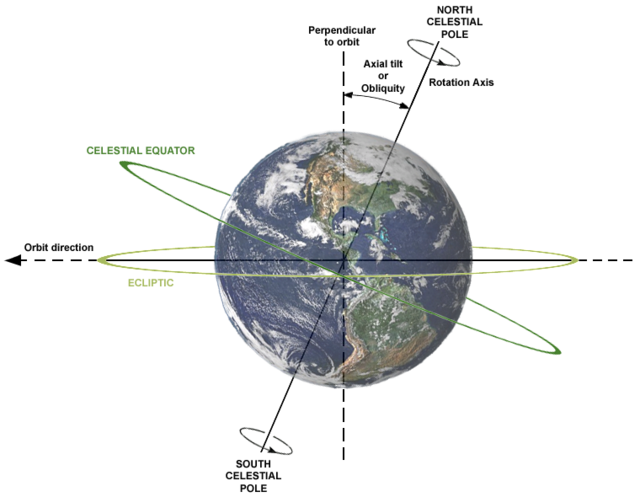
Earth is one of the eight planets in the Solar System. There are also thousands of small bodies which move around the Sun. The Solar System is moving through the Orion Arm of the Milky Way galaxy, and will be for about the next 10,000 years.[112][113]
Earth is about 150,000,000 kilometres or 93,000,000 miles away from the Sun (this distance is called an "astronomical unit" or au. It moves on its orbit at an average speed of about 30 km/s (19 mi/s).[114] Earth turns around about 3651⁄4 times in the time it takes for Earth to go all the way around the Sun.[2] To make up this extra bit of a day every year, an additional day is added to the calendar every four years (February 29). A year that has this extra day is called a "leap year".
The Moon goes around Earth at an average distance of 400,000 kilometres or 250,000 miles. It is locked to Earth, so that it always has the same half facing Earth; the other half is called the "dark side of the moon". It takes about 271⁄3 days for the Moon to go all the way around Earth, but because Earth is moving around the Sun at the same time, it takes about 291⁄2 days for the Moon to go from dark to bright to dark again. This is where the word "month" came from, even though most months now have 30 or 31 days.[115]
Remove ads
Geology of Earth
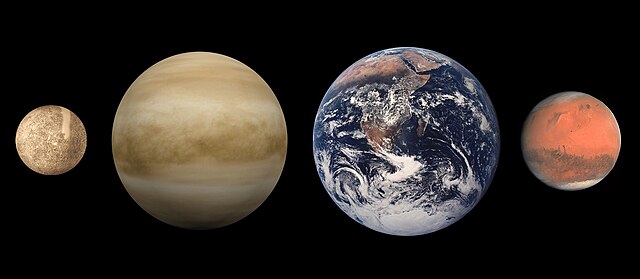
Earth is rocky. It is the largest of the rocky planets moving around the Sun by mass and by size. It is much smaller than the gas giants such as Jupiter.
Chemical make-up
Overall, Earth is made of iron (32.1%), oxygen (30.1%), silicon (15.1%), magnesium (13.9%), sulfur (2.9%), nickel (1.8%), calcium (1.5%), and aluminium (1.4%). The 1.2% left over is made of many different kinds of other chemicals. Some rare metals (not just gold and platinum) are very valuable. Rare earth metals are often used in electronic phones and computers.[116]
The structure of Earth changes from the inside to the outside. The center of Earth (Earth's core) is mostly iron (88.8%), nickel (5.8%), sulfur (4.5%), and less than 1% other elements.[117] The Earth's crust is largely oxygen (47%). Oxygen is normally a gas but it can join with other chemicals to make compounds like water and rocks. 99.22% of rocks have oxygen in them. The most common rocks with oxygen are silica (made with silicon), alumina (made with aluminium), rust (made with iron), lime (made with calcium), magnesia (made with magnesium), potash (made with potassium), and sodium oxide.[118]
Being rich in metals such as iron, the Earth is the densest of all the planets.[119] Mercury and Venus are slightly less dense.
Shape
Earth's shape is a spheroid: not quite a sphere because it is slightly squashed on the top and bottom. The shape is called an oblate spheroid. As Earth spins around itself, centrifugal force forces the equator out a little and pulls the poles in a little. The equator, around the middle of Earth's surface, is about 40,075 kilometers or 24,900 miles long.[120] The reason the Earth is roughly a sphere (and so are all planets and stars) is gravity.[121] Meteorites, on the other hand may be any shape because, in their case, the force of gravity is too weak to change their shape.
The highest mountain above sea level—the well-known Mount Everest (which is 8,848 metres or 29,029 feet above sea level)—is not actually the one that is the farthest away from the center of the Earth. Instead, the sleeping volcano Mount Chimborazo in Ecuador is; it is only 6,263 metres or 20,548 feet above sea level but it is almost at the equator. Because of this, Mount Chimborazo is 6,384 kilometres or 3,967 miles from the center of the Earth, while Mount Everest is closer to it (2 kilometres or 1.2 miles).[122][123][124] Similarly, the lowest point below sea level that we are conscious of is the Challenger Deep in the Mariana Trench in the Pacific Ocean. It is about 10,971 metres or 35,994 feet below sea level,[125] but, again, there are probably places at the bottom of the Arctic Ocean that are nearer to the center of the Earth.
Earth’s core

The deepest hole ever dug is only about 12.3 kilometers or 7.6 miles. We know something about the inside of the Earth, because we learn things from earthquakes and volcanic eruptions. We can detect how quickly shock waves move through the Earth.
The inside of Earth is very different from the outside. Almost all of Earth's liquid water is in the seas or close to the surface. The surface also has a lot of oxygen, which comes from plants. Small and simple kinds of life can live far under the surface, but animals and plants only live on the surface or in the seas. The rocks on the surface of Earth (Earth's crust) are well known. They are thicker where there is land, between 30 to 50 km or 19 to 31 mi thick. Under the seas they are sometimes only 6 km or 3.7 mi thick.[126]
There are three groups of rocks that make up most of the Earth's crust. Some rock is made when the hot liquid rock comes from inside the earth (igneous rocks); another type of rock is made when sediment is laid down, usually under the sea (sedimentary rocks); and a third kind of rock is made when the other two are changed by very high temperature or pressure (metamorphic rocks).
Below the crust is hot and almost-liquid rock which is always moving around (the Earth's mantle). Then, there is a thin liquid layer of heated rock (the outer core). This is very hot: 7,000 °C or 13,000 °F or 7,300 K.[127] The middle of the inside of the Earth would be liquid as well but all the pressure of the rock above it makes it a solid. This solid middle part (the inner core) is almost all iron. It is what makes the Earth magnetic.
Pieces of the crust form plates

The Earth's crust is solid but made of parts which move very slowly.[128] The thin skin of hard rock on the outside of the Earth rests on hot liquid material below it in the deeper mantle.[129] This liquid material moves because it gets heat from the hot center of the Earth. The slow movement of the plates is a factor in earthquakes, volcanoes and large groups of mountains on the Earth.
There are three ways plates can come together. Two plates can move towards each other ("convergent" plate edges). This can form islands, volcanoes, and high mountain ranges (such as the Andes and Himalayas).[130] Two plates can move away from each other ("divergent" plate edges). This gives the warm liquid rock inside the earth a place to come out. This makes special mountain ranges below the sea or large low lands like Africa's Great Rift Valley.[131][132] Plates are able to move beside each other as well ("transform" plate edges, such as the San Andreas Fault). This makes their edges crush against each other and makes many shocks as they move.[133]
Surface
The outside of the Earth is not even. There are high places called mountains, and high flat places called plateaus or plateaux. There are low places called valleys and canyons. For the most part, moving air and water from the sky and seas eats away at rocks in high places and breaks them into small pieces. The air and water then move these pieces to lower places. The fundamental cause of the differences in the Earth's surface is plate tectonics. The shape of the entire planet itself is not an exactly a ball. Because of its spin, Earth has a slight bulge at the Equator.
All places on Earth are made of, or are on top of, rocks. The outside of the Earth is usually not uncovered rock. Over 70% of the Earth is covered by seas full of salty water.[134] This salty water makes up about 971⁄2% of all Earth's water. The drinkable fresh water is mostly in the form of ice. There is only a small amount (less than 3%) of fresh water in rivers and under the ground for people to drink.[135] Gravity stops the water from going away into outer space. Also, much of the land on Earth is covered with plants, or with what is left from earlier living things. Places with very little rain are dry wastes called deserts. Deserts usually have few living things, but life is able to grow very quickly when these wastes have rainfall. Places with large amounts of rain may be rain forests. Lately, people have changed the environment of the Earth a great deal. As population has increased, so has farming. Farming is done on what were once natural forests and grassland.[136][137]
Air
All around the Earth is the of air (the atmosphere). The mass of the Earth holds the gasses in the air down and does not let them go into outer space. The air is mostly made of nitrogen (about 78%) and oxygen (about 21%) and there are a few other gasses as well.[138] Living things need both the air and water.
The air, which animals and plants use to live, is only the first level of the air around the Earth (the troposphere). The day to day changes in this level of air are called weather; the larger differences between distant places, and from year to year, are called the climate. Rain and storms come about because this part of the air gets colder as it goes up. Cold air becomes thicker and falls, and warm air becomes thinner and goes up.[139] The turning Earth also moves the air as well and air moves north and south because the middle of the Earth generally gets more power from the Sun and is warmer than the north and south points. Air over warm water evaporates but, because cold air is not able to take in as much water, it starts to make clouds and rain as it gets colder. The way water moves around in a circle like this is called the water cycle.[139]
Above this first level, there are four other levels. The air gets colder as it goes up in the first level; in the second level (the stratosphere), the air gets warmer as it goes up. This level has a special kind of oxygen called ozone. The ozone in this air keeps living things safe from damaging rays from the Sun. The power from these rays is what makes this level warmer and warmer. The middle level (the mesosphere) gets colder and colder with height; the fourth level (the thermosphere) gets warmer and warmer; and the last level (the exosphere) is almost outer space and has very little air at all. It reaches about half the way to the Moon. The three outer levels have a lot of electric power moving through them; this is called the ionosphere and is important for radio and other electric waves in the air.
Even though air seems very light, the weight of all of the air above the outside of the Earth (air pressure) is important. Generally, from sea level to the top of the outer level of the air, a space of air one cm2 across has a mass of about 1.03 kg and a space of air one sq in across has a weight of about 14.7 lb. Because of friction in the air, small meteorites generally burn up long before they get to the Earth.
The air also keeps the Earth warm, specially the half turned away from the Sun. Some gasses – especially methane and carbon dioxide – work like a blanket to keep things warm.[140] In the past, the Earth has been much warmer and much colder than it is now. Since people have adapted to the heat we have now, we do not want the Earth to be too much warmer or colder. Most of the ways people create electric power use burning kinds of carbon – especially coal, oil, and natural gas. Burning these fuels creates more carbon dioxide which causes more warming. A discussion is going on now about what people should do about the Earth's latest warming, which has gone on for about 150 years. So far, this warming has been acceptable: plants have grown better. The weather has generally been better than when it was colder.
Remove ads
People
About eight billion people live on Earth. They live in about 200 different lands called countries. Some, for example, Russia, are large with many large cities. Others, for example, Vatican City, are small. The seven countries with the most people are India, China, the United States, Indonesia, Pakistan, Brazil and Nigeria. About 90% of people live in the northern hemisphere of the world, which has most of the land. Human beings originally came from Africa. Now, 70% of all people do not live in Africa but in Europe and Asia.[141]
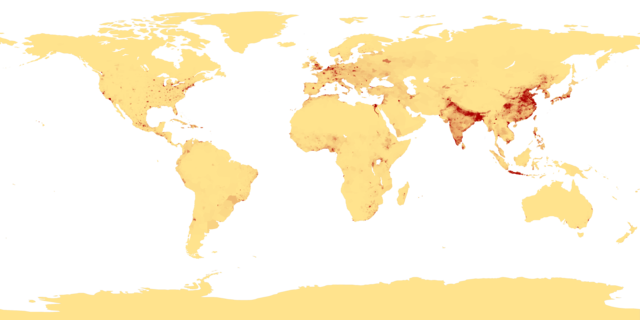
People change the Earth in many ways. They have been able to grow plants for food and clothes for about ten thousand years. When there was enough food, they were able to build towns and cities. Near these places, men and women were able to change rivers, bring water to farms, and stop floods (rising water) from coming over their land. People found useful animals and bred them so they were easier to keep.[142]
Remove ads
Future
There is wide agreement that the long-term future of Earth is tied to the future of the Sun.[143] As time passes, the Sun will get hotter, and that will eventually make the Earth a planet without life.
Gallery
Related pages
Notes
- Seidelmann, P. Kenneth (ed.). Explanatory Supplement to the Astronomical Almanac, 3rd edition, University Science Books, 2005, p. 604. ISBN 0-935702-68-7.
- Seidelmann, P. K. (ed.) (2005). Explanatory Supplement to the Astronomical Almanac, 3rd edition, University Science Books, p. 604. ISBN 0-935702-68-7.
- Earth's circumference is almost exactly 40,000 km because the meter was calibrated on this measurement—more specifically, 1/10-millionth of the distance between the poles and the equator.
Remove ads
References
Other websites
Wikiwand - on
Seamless Wikipedia browsing. On steroids.
Remove ads


